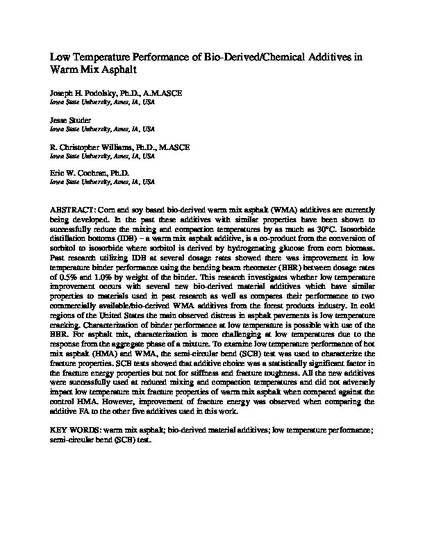
Corn and soy based bio-derived warm mix asphalt (WMA) additives are currently being developed. In the past, additives with similar properties have been shown to successfully reduce the mixing and compaction temperatures of asphalt by as much as 30°C. Isosorbide distillation bottoms (IDB), a WMA additive, is a co-product from the conversion of sorbitol to isosorbide, where sorbitol is derived by hydrogenating glucose from corn biomass. Past research utilizing IDB at several dosage rates showed there was improvement in low temperature binder performance using the bending beam rheometer (BBR) between dosage rates of 0.5% and 1.0% by weight of the binder. This research investigates whether low temperature improvement occurs with several new bio-derived material additives that have similar properties to materials used in past research, as well as compares their performance to two commercially available/bio-derived WMA additives from the forest products industry. In cold regions of the United States, the main observed distress in asphalt pavements is low temperature cracking. Characterization of binder performance at low temperature is possible with the use of the BBR. For asphalt mixtures, characterization is more challenging at low temperatures due to the response from the aggregate phase of a mixture. To examine low temperature performance of hot mix asphalt (HMA) and WMA, the semi-circular bend (SCB) test was used to characterize the fracture properties. SCB tests showed that additive choice was a statistically significant factor in fracture energy properties but not for stiffness and fracture toughness. All of the new additives were successfully used at reduced mixing and compaction temperatures and did not adversely impact low temperature mix fracture properties of WMA when compared against the control HMA. However, improvement of fracture energy was observed when comparing the epoxidized esterified fatty acid additive to the other five additives used in this work.
Available at: http://works.bepress.com/rc_williams/42/

This is a manuscript of a proceeding published as Podolsky, Joseph H., Jesse Studer, R. Christopher Williams, and Eric W. Cochran. "Low temperature performance of bio-derived/chemical additives in warm mix asphalt." ASCE 16th International Cold Regions Conference Proceedings, Salt Lake City, Utah, July 19-22, 2015. In Cold Regions Engineering 2015, pp. 241-251. 2015. DOI: 10.1061/9780784479315.022. Posted with permission.